Robert Gottlieb in The New York Times:
 This is the centenary year of “Babbitt,” Sinclair Lewis’s best — and most misunderstood — novel. He had written five inconsequential books that had received respectable if not excited attention. And in 1920 — at the age of 35 — he had written “Main Street,” the most sensationally successful novel of the century to date: hundreds of thousands of copies sold, and a title that came to stand for the values, both narrow-minded and wholesome, of what we now call Middle America.
This is the centenary year of “Babbitt,” Sinclair Lewis’s best — and most misunderstood — novel. He had written five inconsequential books that had received respectable if not excited attention. And in 1920 — at the age of 35 — he had written “Main Street,” the most sensationally successful novel of the century to date: hundreds of thousands of copies sold, and a title that came to stand for the values, both narrow-minded and wholesome, of what we now call Middle America.
The Pulitzer Prize jury chose it as the year’s best novel, but in a scandalous reversal of their decision, the prize’s trustees refused to approve the award and presented it instead to Edith Wharton’s “The Age of Innocence.” A few years later, when the judges chose Lewis’s “Arrowsmith,” he refused to accept the prize — Sinclair Lewis had a thin skin. (Nothing ever changes: When in 1974 the jury unanimously chose Thomas Pynchon’s “Gravity’s Rainbow,” the prize’s overseers again refused to certify the decision, using words like “turgid” and “obscene” to justify their action.)
At the time of their publication, both “Main Street” and “Babbitt” were generally thought of as satirical novels, America being the object of the satire. Both “Main Street”’s Gopher Prairie, the small town that is the stand-in for Sauk Centre, Minn., where Lewis grew up, and Zenith, the medium-size city where Babbitt conducts his prosperous realty business, are meticulously and convincingly anatomized: Lewis always got the details right.
More here.
